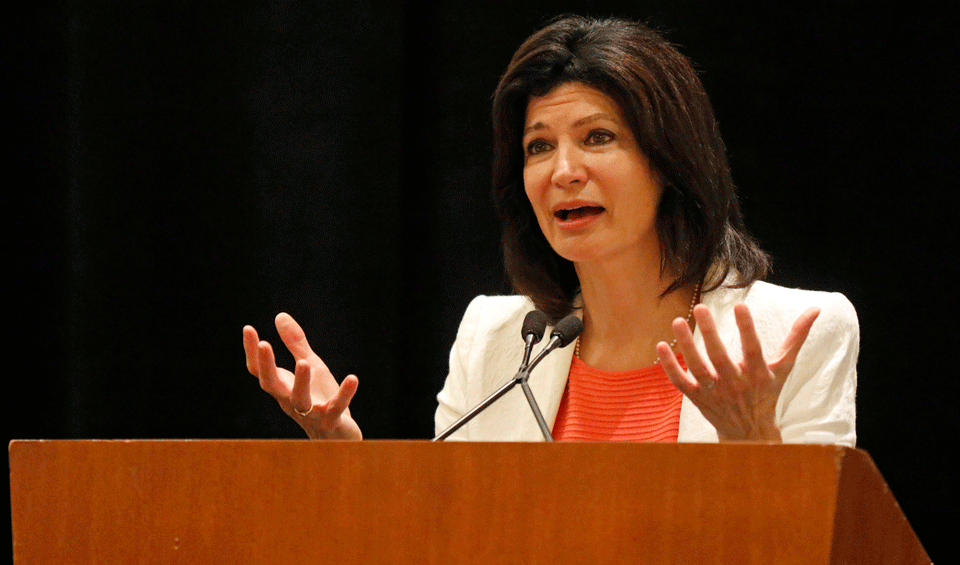
WASHINGTON—GOP President Donald Trump’s “back to school” command, despite the galloping coronavirus pandemic, endangers kids, their parents and their teachers, the president of the nation’s largest teachers union says.
And it isn’t going to deflect local school boards from working with teachers, staffers, and parents to prepare and implementing careful plans to help kids learn this coming school year, Lily Eskelsen-Garcia predicts.
Those plans, she said, will vary from district to district. They’ll be a combination of continued distance learning via computers, tablets, and Zoom “virtual classrooms” and careful physical reopening of the nation’s 100,000 school buildings, once boards and administrators create drastically reduced capacity, start daily coronavirus testing and provide pandemic prevention measures, sanitizing, face masks and protective equipment, she adds.
Eskelsen-Garcia, who steps down August 31 from her presidency of the nation’s largest union, the National Education Association, gave that double answer to Trump and his anti-teacher, anti-public school Education Secretary, Elizabeth “Betsy” DeVos, in a half-hour interview July 28 with Washington Post writer Eugene Scott.
“We are carefully working with the school boards, the health inspectors, the parents, and the kids” to determine what’s best to do when schools are supposed to start again in late August, said Eskelsen-Garcia, a primary-grade teacher from Salt Lake City. “We are not waiting for Betsy DeVos. That wouldn’t work.”
“And then the president of the United States steps in and waves his hands and commands us to ‘Go back!’ and ‘Just do it!’”
“That’s outraged parents and educators and it’s endangered kids,” she declared.
Rather than heed Trump, “I rely on the experts—the Dr. Faucis—to tell us what to do to be safe,” she said, referring to the nation’s top infectious disease expert, Dr. Anthony Fauci of the National Institute of Allergies and Infectious Diseases. He’s consistently contradicted Trump’s edicts.
Trump also lauded Scandinavian nations, specifically Norway, Sweden, and Denmark, for bringing the coronavirus’s impact down to the point where they have reopened their schools. “That’s because they did it”—closed down—“nationally, and they took it (the pandemic) seriously early,” Eskelsen-Garcia replied. “That’s the exact opposite of what we’ve done.”
Fauci made the same point in a Post interview just days before. He said only 50% of the U.S. closed to battle the pandemic, and that was a mistake.
But there’s one big problem with physically reopening the schools, Eskelsen-Garcia warned: Money.
School systems rely on local property tax and/or state income tax revenues for most of their funding, NEA figures repeatedly show. Those revenues collapsed as joblessness due to forced closures to battle the coronavirus pandemic increased.
School districts from coast to coast are hurting for funds to provide daily virus testing, personal protective equipment, cut classroom capacity, and stage split shifts, all to lessen the possibility of community spread of the coronavirus in the schools. And testing “has to be done to everybody,” daily, she added.
“Otherwise, your school will be your superspreader” of the virus, she warned. “Look at what happened at those bars” that GOP governors let reopen in May and June. “If there’s one (positive coronavirus) case, we might have to close the whole school down.”
The House-passed $3 trillion Health and Economic Recovery Omnibus Emergency Solutions (Heroes) Act, HR6800, includes funds for the schools and almost $1 trillion for the states, too. But Senate Majority Leader Mitch McConnell, R-Ky., has deep-sixed it, and Trump threatens a veto. McConnell’s skimpy alternative bill has $100 billion for schools and nothing for the state and local governments.
It’s those poor kids, who are predominantly children of color, who need the help the most, Eskelsen-Garcia said. That’s because unlike white suburban kids, or those in private schools, they were trying to learn in the nation’s oldest school buildings, with the fewest supplies, and the least outside help from cash-starved districts which cut nurses, aides, counselors and mental health professionals in past years.
Repeating a frequent NEA theme, she says the quality of education now “depends on your zip code.”
If the funds are found, “the help should go first to the kids who need it most”—“Black and brown and minority and immigrant kids,” ones for whom English is a second language and those with special needs. The last group, who often need home health care aides and other specialists, will also be the toughest to teach when schools reopen, she said.
And, school administrators point out, the poor kids were also least-equipped for distance learning when the pandemic shut all the nation’s schools, starting in March. Rather than computers, their families had cell phones, which parents—often classified as essential workers—had to take to their jobs. And inner-city districts lacked WiFi hotspots, too.
Scott’s second guest on reopening the schools, Miami-Dade School Superintendent Alvaro Carvalho, made those points to Scott in the second half-hour on the issue.
Carvalho said his school system, the fourth-largest in the continental U.S., would be very cautious about letting its students come back to their classrooms. Other systems, he added, would also react to local coronavirus conditions.
Carvalho split school systems, even in Florida, into those in coronavirus hot spots, such as his, and those in “cool spots,” leaving the decisions local. He also was more diplomatic than Eskelsen-Garcia, a primary-grade teacher from Salt Lake City, about the open-the-schools now demands of Trump, DeVos, and Gov. Ron DeSantis, R-Fla., a slavish Trumpite,
DeSantis’s too-soon reopening of beaches, bars, shops, and shopping malls catapulted the Sunshine State into the #2 spot nationwide in cumulative positive coronavirus cases, with 432,747 as of 8:30 am July 28, and it’s catching up to #1 California. Miami-Dade, with 107,315 cases, is third among the nation’s 3,000-plus counties and gaining on #2 Maricopa (Phoenix), Ariz.

MOST POPULAR TODAY

Zionist organizations leading campaign to stop ceasefire resolutions in D.C. area


High Court essentially bans demonstrations, freedom of assembly in Deep South

Afghanistan’s socialist years: The promising future killed off by U.S. imperialism

Communist Karol Cariola elected president of Chile’s legislature






Comments